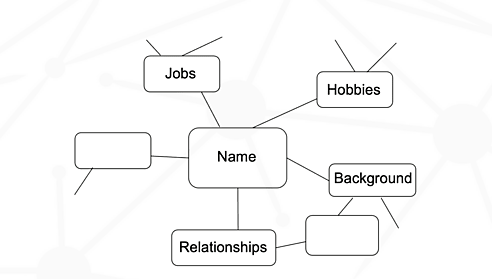- Brainstorm individually and collectively to find out who we are and what matters to us and to others.
- Reflect on what makes us who we are in relation to a text given.
- Identify and analyze various roles that play in different aspects of students’ lives.
Learning Objectives
Essential Questions
- How does knowing who we are help us address how we approach life?
- How does identifying in a certain way make us empathetic?
- How can knowing who we are help us in moving forward with this unit?
Materials
- Blank piece of paper for identity maps; if possible, paper should be lined on one side for reflection
- Pens or pencils; colored pencils, markers, crayons, etc.
- Whiteboard, chalkboard, or some digital way of writing while students talk
Warm‐Up
Ask students to read the poem you assign. “Still I Rise” by Maya Angelou works well here. Discuss:
- What does this poem show us about who we are?
- How does the author of this poem show us who they are? How do you show yourself to others?
- How does the person in the poem feel about themselves? How can you tell?
- If you were to create a poem about yourself, what would it include?
- How did the world around the author shape them? How does the world around you shape you?
Part I: Brainstorm and Map Creation
Brainstorm with the class the many ways that we can identify ourselves. When brainstorming, ask students for general categories (relationships, jobs, identity), not specific examples (sister, teacher, female) as those things will come later. Students can use electronic devices for brainstorming to facilitate the flow of ideas. Feel free to broaden the discussion to explore roles in various categories, such as community, nation, environment, or neighborhood. Students may also want to think about their hobbies and personal interests.
As students share ideas, create an identity map template using a mind map form by writing on the board what the students say; use your name or a generic title in the middle and add what the students say around it.

After the identity map template has been created by the class discussion, give students time to individually create a mind map of their own. Students are more than welcome to add on to whatever template the class has created or take away sections.
Part II: Discussion
After students create their identity maps, discuss them. During the discussion, have students answer any questions on the other side of their paper or in their notebooks. Here are some questions that can aid in the discussion:
- What are some aspects of our identity that never change?
- What are some aspects that are constantly changing?
- What are some of your different roles that you have? Relationships?
- Which of the things on your map are identities that you claim versus those that were put on you by someone else?
- Which of these identities are very important to you? Which are not?
Ask students to share as they are willing.
Part III: Reflection
After students discuss aspects of identity and the way they define themselves, here are some questions that can aid in the reflection. They can share out loud or answer in their notebook:
- How does your parent’s version of you differ from your own? Do they have different goals and ideas for you than you do for yourself?
- What stereotypes do people assume about you that aren’t true?
- What do you know/like/dislike about your name?
- Who are you, and what do you want to say about your culture?
- How might you see yourself differently than how others may see you?
Closing the Lesson
If students are not finished creating their identity maps, they can continue to work as the teacher asks the closing questions. These can be used at the end of class to bring the topics of the day’s lessons together:
- How does knowing who we are help us address how we approach life?
- How does identifying in a certain way make us empathetic?
- How can knowing who we are help us in moving forward with this unit about people who may be similar to but also different from who we are?
- People change and so do their roles. What changes have already happened in your life?
Common Core State Standards
- CCSS.ELA-LITERACY.W.9–10.2: Write informative/explanatory texts to examine and convey complex ideas, concepts, and information clearly and accurately.
- CCSS.ELA-LITERACY.SL.9–10.1: Initiate and participate effectively in a range of collaborative discussions (one‐on‐one, group, and teacher‐led) with diverse partners on grades 9–10 topics, texts, and issues, building on others’ ideas and expressing their own clearly and persuasively.
- CCSS.ELA-LITERACY.SL.9–10.1.C: Propel conversations by posing and responding to questions that relate the current discussion to broader themes or larger ideas; actively incorporate others into the discussion.
Social‐Emotional Learning Standards
CASEL (Collaborative for Academic, Social, and Emotional Learning) has standards that align with the lesson’s focus on self‐awareness and self‐management.
NAEA Art Standards
VA:Cr2.1.Ia: Engage in making a work of art or design without having a preconceived plan.
